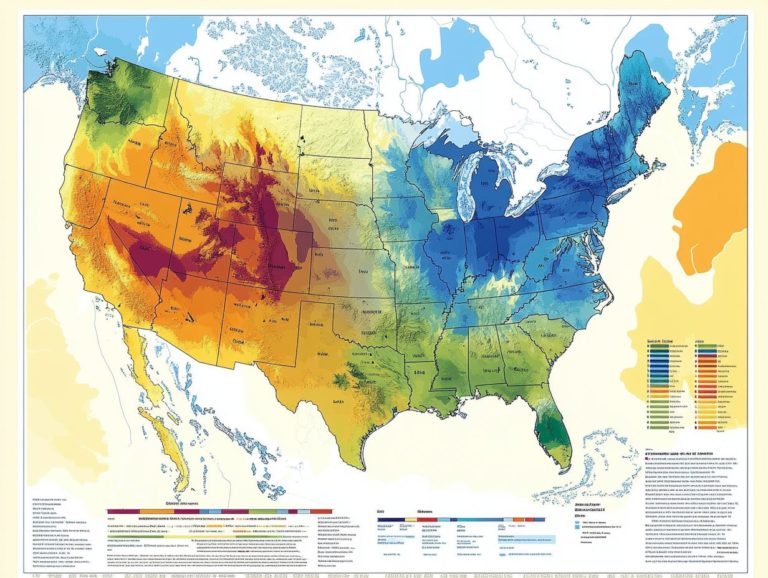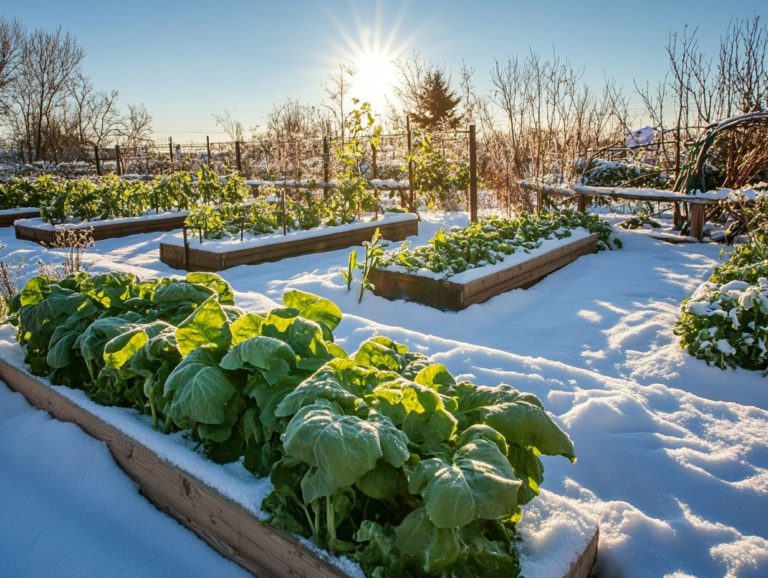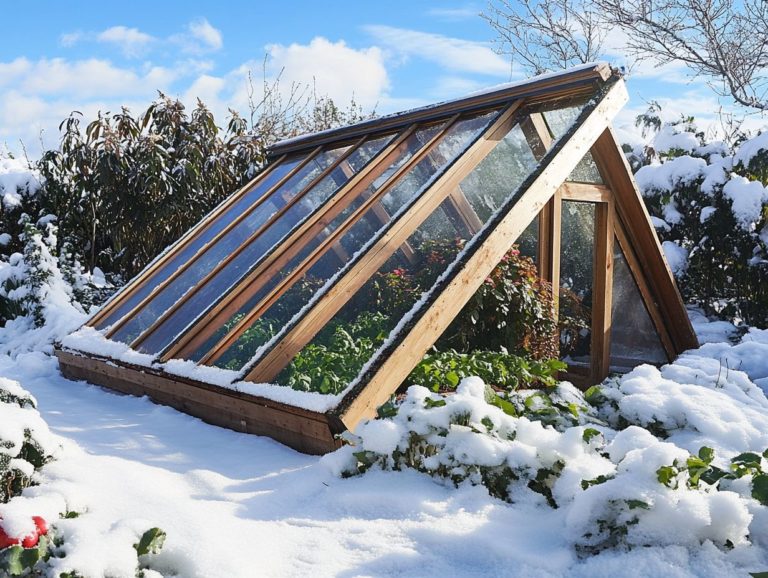How to Choose the Right Winter Cover Crops
As winter draws near, get ready to discover how to protect your soil this winter!
Winter cover crops are an effective strategy for preserving soil health, enhancing nutrient retention, and keeping pesky weeds and pests at bay.
In this article, you ll learn what winter cover crops are, the many benefits they offer, and essential factors to consider when choosing the right varieties for your garden.
From grasses to legumes, you’ll be guided in making informed decisions that will lead to a flourishing garden come spring.
Contents
- Key Takeaways:
- What are Winter Cover Crops?
- Benefits of Using Winter Cover Crops
- Factors to Consider When Choosing Winter Cover Crops
- Types of Winter Cover Crops
- How to Select the Right Winter Cover Crops for Your Garden
- Frequently Asked Questions
- What are winter cover crops and why should I use them?
- How do I choose the right winter cover crops for my garden?
- Can I plant a single cover crop or should I use a mix?
- When should I plant winter cover crops?
- How do I incorporate the cover crops into my garden in the spring?
- Are winter cover crops suitable for all types of gardens?
Key Takeaways:

- Winter cover crops boost soil health by holding onto nutrients and fighting weeds.
- Think about your climate and soil when selecting cover crops.
- Mix different types like grasses and legumes for a thriving winter garden.
What are Winter Cover Crops?
Winter cover crops play a crucial role in farming that is good for the environment. They act as a critical tool for improving soil health and helping nutrients move through the soil.
Varieties such as winter rye and crimson clover are typically grown during winter. They enrich the soil with organic matter, improve its structure, and prevent erosion.
Influential advocates like Jack Algiere at the Stone Barns Center in New York City promote their use in changing the types of plants you grow in a certain area each season to improve soil health. By incorporating these practices, you not only help the soil but also engage in a more sustainable form of agriculture.
Benefits of Using Winter Cover Crops
Using winter cover crops brings a wealth of benefits that greatly enhance soil health. They improve nutrient retention and boost overall fertility.
These crops also prevent soil compaction and erosion while effectively suppressing weeds. They provide homes for helpful organisms that control pests.
By carefully integrating various plant types, you can optimize your garden and create a diverse ecosystem that nurtures robust growth throughout the seasons.
Soil Health and Nutrient Retention
Soil health can be significantly enhanced through winter cover crops. They help nutrients move and are reused in the soil, leading to richer soil fertility.
By using composting techniques in your gardening or farming practices, you can create a robust soil food web that supports healthy plant growth across various hardiness zones.
This approach promotes better aeration and moisture retention while introducing helpful tiny organisms that efficiently break down organic matter.
For optimal results, consider mulching. It s an effective strategy that helps regulate soil temperature and minimize erosion.
Practicing crop rotation alongside winter cover crops can also help reduce pest issues and improve soil biodiversity. Experiment with different cover crops, such as clover or rye, to tailor the mix to your specific soil needs and climate conditions.
Ultimately, these practices work together synergistically, enhancing overall soil fertility, ecosystem health, and crop productivity.
Weed Suppression and Pest Control
Winter cover crops are a fantastic choice for weed suppression. They create a natural barrier that stops unwanted plants from growing while also fostering an ecosystem that supports beneficial insects for pest control. These cover crops promote crop diversity, enhancing the resilience of your garden against pests and diseases.
The functionality of these cover crops is multifaceted. They not only outcompete weeds for essential nutrients and light but also disrupt the life cycles of harmful insects. Varieties like clover and rye enrich your soil and attract predatory insects such as ladybugs and lacewings, which feed on common garden pests.
Crop rotation and mixing different plant species create a complex habitat that discourages pest infestations and enhances soil health. If you’re seeking effective gardening methods, these strategies can significantly improve your crop yield and sustainability, transforming your gardening experience into something that’s not only more productive but also environmentally friendly.
Factors to Consider When Choosing Winter Cover Crops

Selecting the ideal winter cover crops requires careful thought. Consider critical factors such as climate and soil conditions, as these elements are vital for determining the best cover crops for cold-climate gardens that will thrive in your garden.
Familiarizing yourself with hardiness zones and adopting suitable planting techniques can greatly enhance the effectiveness of your cover crop choices. This ensures robust growth and long-term sustainability in your agricultural endeavors.
Climate and Soil Conditions
The climate and soil conditions in your area are essential for the successful growth of winter cover crops. To ensure you select the best options, consider how to choose the right winter garden variety, as these factors influence everything from soil structure to crop health and how well plants can add nutrients back to the soil.
Different regions have varying temperatures, precipitation levels, and soil types. These factors are crucial in determining which cover crops will be most effective for you. For instance, if you live in an area with colder winters, you should consider how to prepare your soil for winter crops by choosing hardier species that can withstand frost. Conversely, those in milder climates can enjoy a wider selection of options.
Certain cover crops are particularly good at putting nitrogen back in the soil, providing nutrients that benefit your subsequent crops. By skillfully selecting the right combinations based on your unique growing conditions, you can enhance soil fertility, improve water retention, and reduce erosion, paving the way for a sustainable gardening practice.
Planting and Harvesting Time
Understanding the optimal planting and harvesting times for winter cover crops is key to maximizing their benefits in your garden. This knowledge helps you align with seasonal crops and use effective gardening techniques. Proper timing boosts crop health and improves nutrient cycling.
When integrating these cover crops into your practices, consider your regional climate and the specific needs of the crops you choose. For example, planting cover crops like rye or clover in the fall ensures they establish well before winter, allowing them to thrive even in colder temperatures. Refer to the ultimate guide to winter crop care for more tips on managing your winter gardening effectively.
Timing your harvest is just as crucial. Waiting too long can lead to bolting or reduced biomass, while harvesting too early might limit soil benefits. Keep an eye on weather forecasts; early frosts or excessive rainfall can significantly impact your planting schedules and crop performance.
Types of Winter Cover Crops
You have a wealth of options with winter cover crops, including grasses, legumes, and broadleaf varieties. To maximize their benefits, learn how to use row covers for winter crops, as each type offers distinct advantages that enrich soil health and fertility.
By exploring diverse cover crop mixes, you can customize your selections to align with your specific agricultural goals, thereby enhancing nutrient cycling and improving overall soil structure.
Start selecting your winter cover crops today for a successful gardening season!
Grasses and Legumes
Grasses and legumes play a crucial role in winter cover crops. Legumes especially excel at nitrogen fixation, enriching soil fertility and supporting sustainable agriculture.
Combining these plant varieties sets the stage for numerous benefits. This creates a solid foundation for healthy soil and flourishing garden crops.
Grasses establish robust root systems to prevent soil erosion and enhance soil structure. This leads to improved water infiltration.
Legumes excel in the nitrogen cycle. They form partnerships with bacteria in their root nodules that convert atmospheric nitrogen into a plant-absorbable form.
This natural process reduces reliance on synthetic fertilizers. As a result, your agricultural practices become more ecologically sound.
These crops do more than replenish essential nutrients; they promote biodiversity and improve organic matter. This synergy contributes to a sustainable agricultural ecosystem, helping your gardening endeavors thrive for years.
Brassicas and Other Options

Brassicas are an exciting choice for winter cover crops that provide vital soil protection. They offer unique advantages for your gardening methods and crop rotation strategies.
These versatile plants suppress weeds while enhancing soil structure. They also create a welcoming habitat for beneficial organisms.
Incorporating brassicas combats erosion during colder months. This ensures your soil remains intact and healthy.
Using these crops in your rotation helps break disease and pest cycles. As a result, you foster a more balanced ecosystem.
Both farmers and gardeners appreciate the nutrient-rich biomass these crops produce. This can be tilled back into the soil, enriching it for the upcoming growing season.
Embracing brassicas supports the health of your garden and contributes significantly to sustainable agricultural practices.
How to Select the Right Winter Cover Crops for Your Garden
Selecting the ideal winter cover crops requires thoughtful evaluation of your garden’s needs. It’s important to know how to use cover crops for soil health and understand the most effective combinations that align with your goals.
Successful gardening strategies depend on considering essential factors like soil health and climate conditions. Make sure you identify the ecological benefits you wish to achieve.
Assessing Your Garden’s Needs
Assessing your garden’s needs is vital for selecting the right winter cover crops. To make an informed choice, consider factors like soil fertility and your gardening goals, and explore what cover crops are suitable for cold climates.
A thoughtful assessment promotes crop diversity and enhances the overall health of your garden ecosystem. Examine soil composition, moisture retention, and nutrient levels to pinpoint any deficiencies or excesses.
Consider the types of crops you plan to cultivate, as some thrive under specific soil conditions. For instance, integrating legumes can naturally elevate nitrogen levels, while deep-rooted crops improve soil structure.
Understanding what you want to harvest, whether for food production, stunning floral displays, or enriching the soil, will guide your selection of cover crops. This ultimately nurtures a flourishing and sustainable garden environment.
Choosing the Best Cover Crop Combination
To choose the best cover crop combination, understand your gardening resources. Consider the nutrient needs of your soil and your goals for crop health and sustainability.
A thoughtfully planned combination can significantly enhance soil structure and fertility. This ultimately benefits the entire ecosystem of your garden.
Assess critical factors like soil type, climate conditions, and your desired crop outcomes. For example, incorporating legumes is a smart move because they help plants get essential nutrients, while grasses improve soil texture and increase organic matter content.
Using cover crops in rotation helps suppress weeds and reduce pest prevalence. This creates a healthier environment for your subsequent plants.
By integrating ecological gardening practices, you promote biodiversity and bolster resilience against environmental stressors. This paves the way for long-term sustainable and productive horticulture.
Frequently Asked Questions
What are winter cover crops and why should I use them?

Winter cover crops protect and improve your soil during the colder months. They prevent erosion, add nutrients, and suppress weeds.
How do I choose the right winter cover crops for my garden?
First, consider what you want to achieve with your cover crops. Do you want to improve soil health, add nitrogen, or attract beneficial insects? Research which cover crops are best suited for your climate and soil type.
Can I plant a single cover crop or should I use a mix?
It is best to use a mix of cover crops to maximize their benefits. A diverse mix can provide different nutrients, improve soil structure, and attract various beneficial insects.
When should I plant winter cover crops?
The best time to plant winter cover crops varies based on your location and climate. Generally, they should be planted after the last harvest of the year and before the first frost. This allows time for the cover crops to establish before winter.
How do I incorporate the cover crops into my garden in the spring?
In spring, you can either mow or till the cover crops into the soil. This adds organic matter and releases nutrients for your next crop. Alternatively, cut and remove the cover crops, leaving the roots in the ground to decompose.
Are winter cover crops suitable for all types of gardens?
Yes, winter cover crops can benefit all types of gardens, including vegetable and flower gardens, and even lawns. They improve soil health and add nutrients, making them a valuable addition to any garden.
Start your cover crop journey today and watch your garden thrive!






